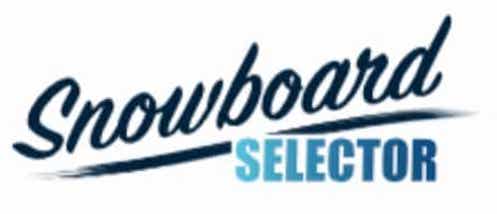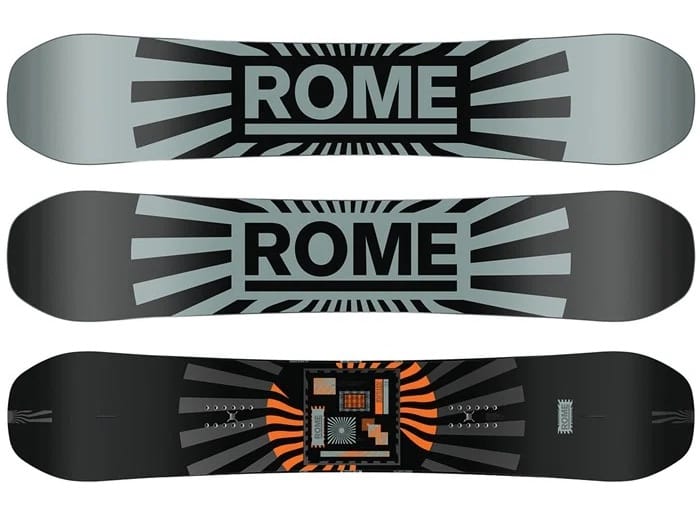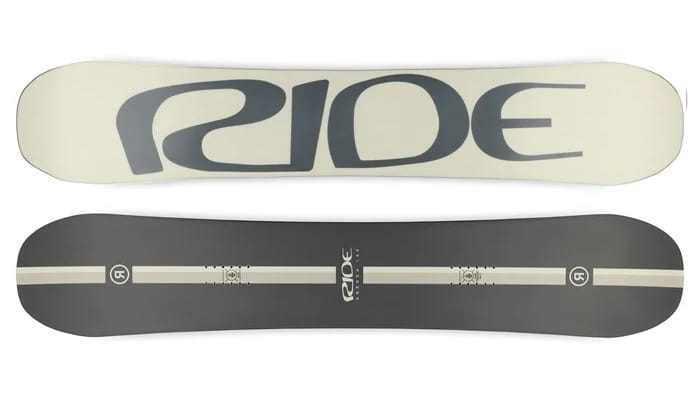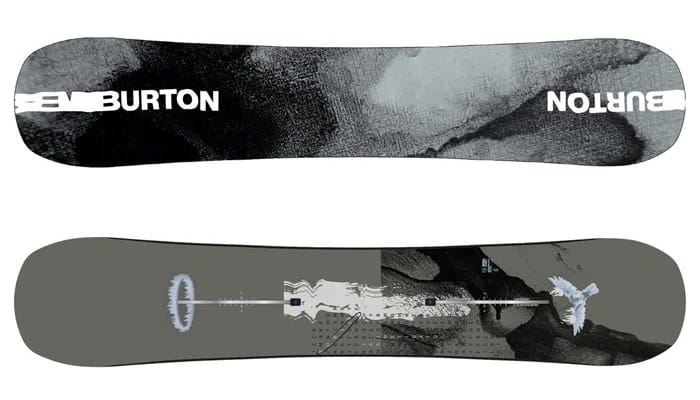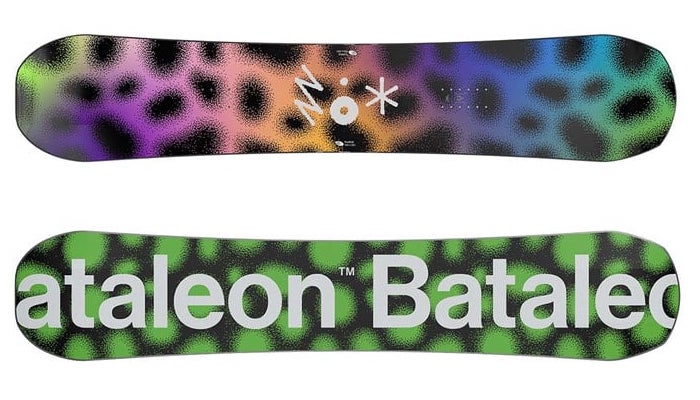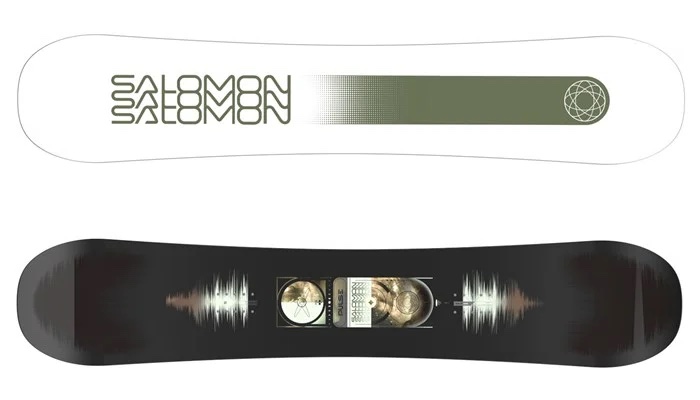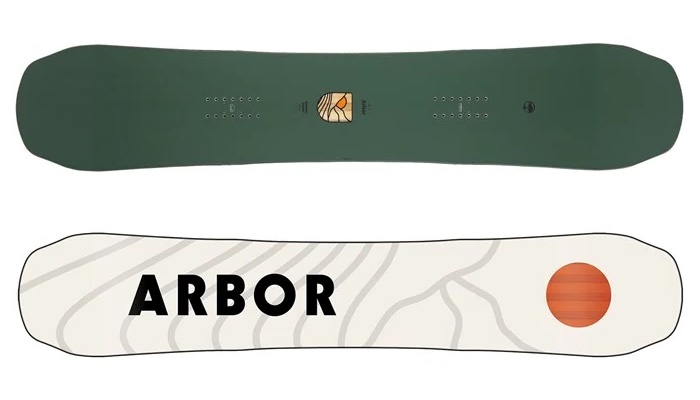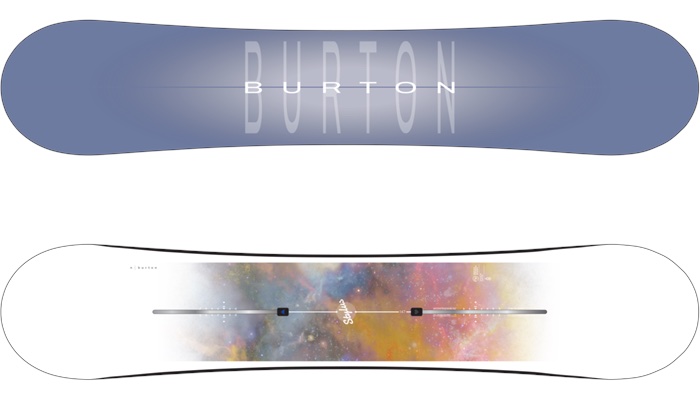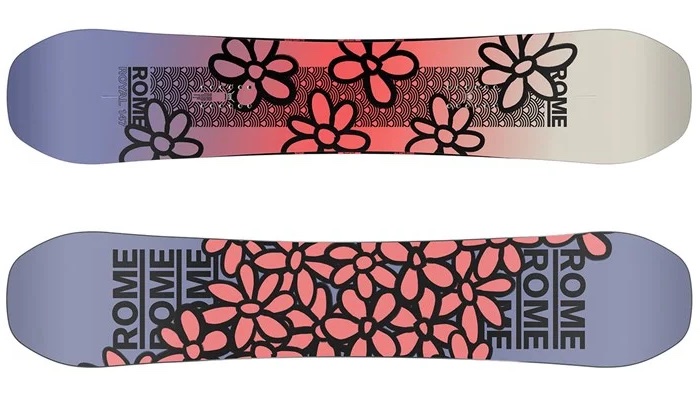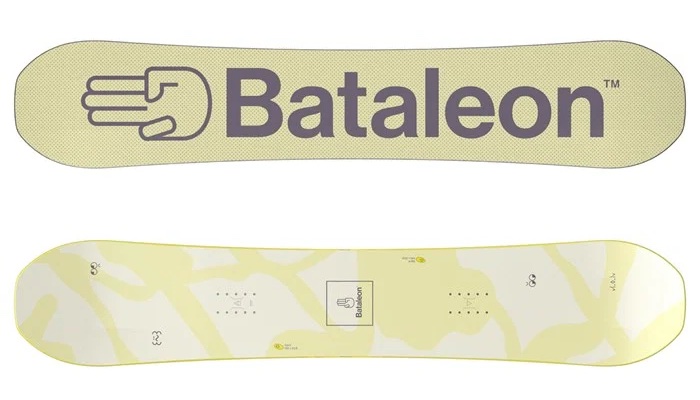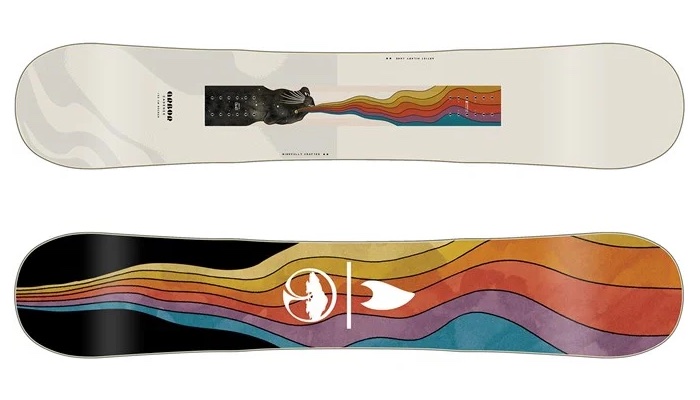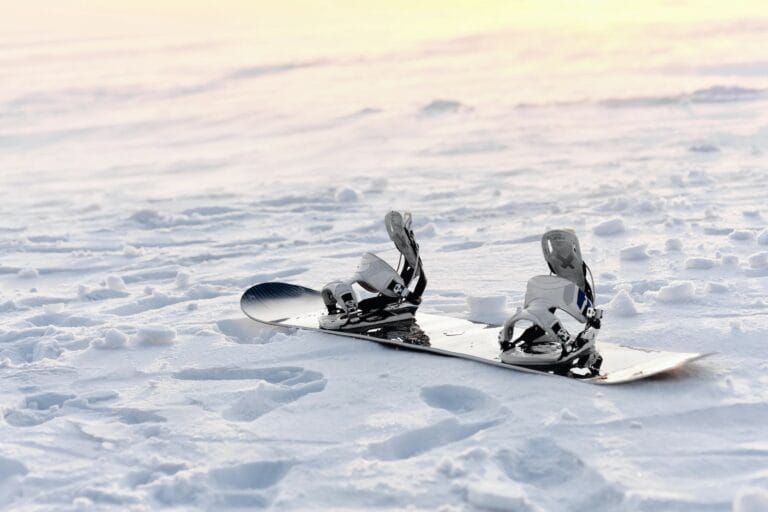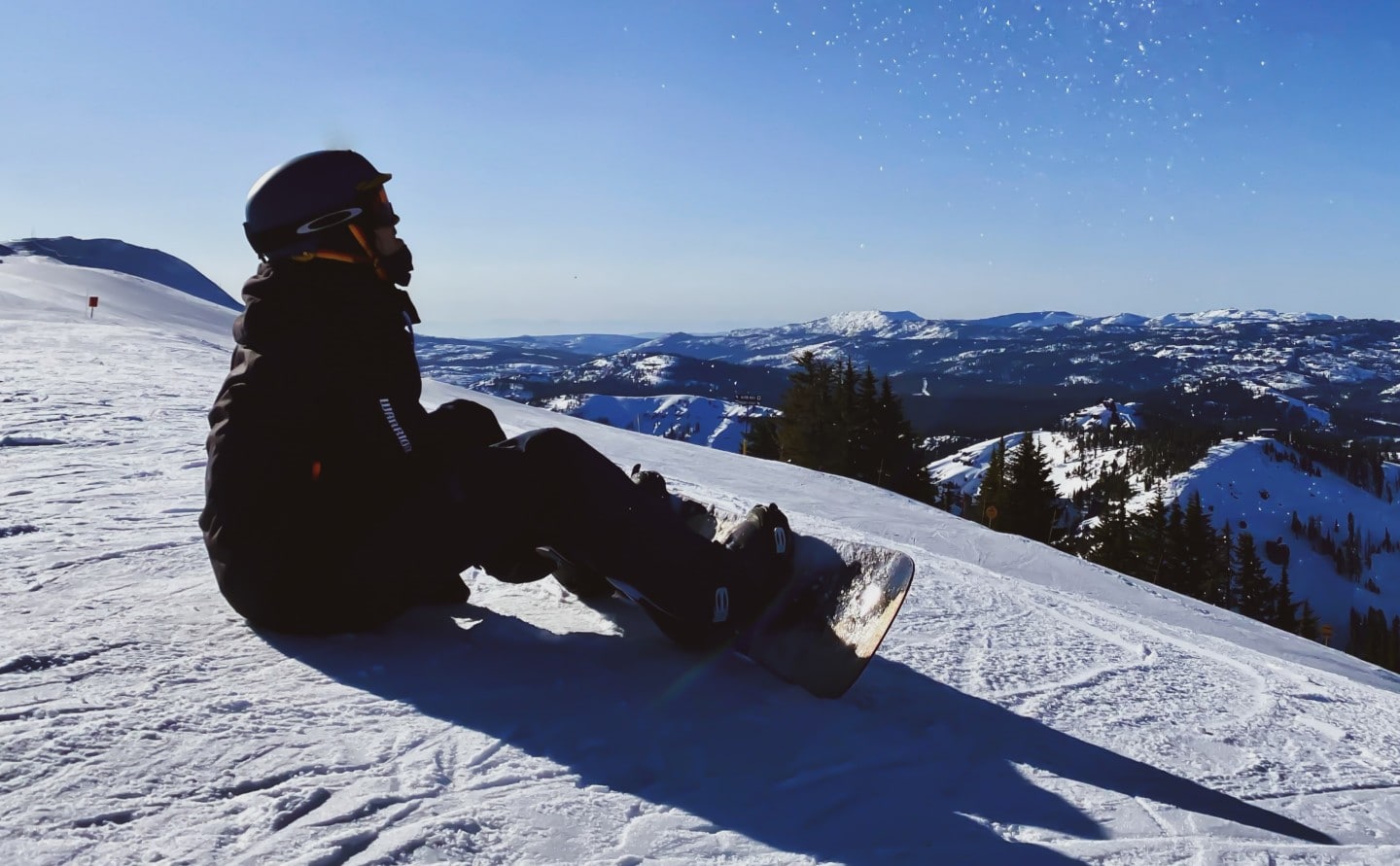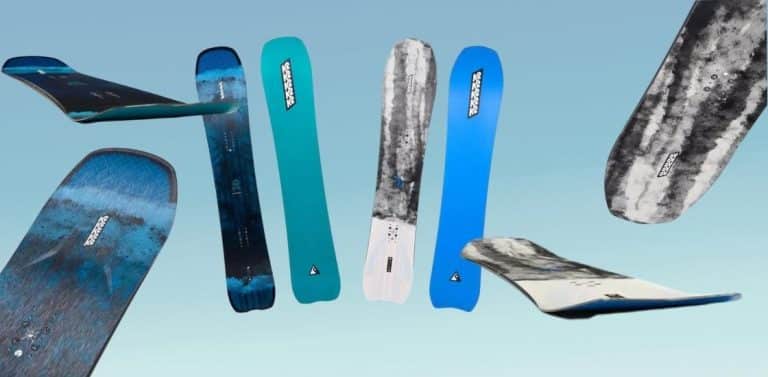Whilst you can learn to snowboard on pretty much any board, picking the right kind of board is going to make the learning process a lot more fun and enjoyable. Here I'll explain what makes a great board to learn on and outline my picks for the best beginner boards in 2025.
Don't know what size snowboard to get? Try out our snowboard size calculator to help take the guesswork out of finding a new board.
Best Men's Beginner Snowboards
Rome's beginner snowboard is flat between the bindings with a slight early rise rocker for a loose and playful feel, whilst minimizing the risk of those pesky edge catches. A flex rating of 4/10 means it's easy to maneuver at lower speeds and easy to pop ollies or bend into a tailpress.
Thin rods of bamboo run from the boards binding mounts out toward the tip and tail. These Bamboo HotRods give the board its pop and playful feel without making the board too torsionally stiff to keep it easily maneuverable.
Its true twin shape means it rides the same in either direction, so switch riding is a cinch. This makes the Mechanic a great choice for any beginner looking to get into freestyle, and pop their first 180.
The Ride Agenda is twin hybrid rocker board. It has positive camber between the feet for pop, and reverse camber toward the tip and tail. This early rise in the tip and tail gives a shorter effective edge which helps easy initiation for turns whilst making it less likely that you'll catch an edge.
The camber between the feet gives a little bit more pop and liveliness, but the board keeps a soft to medium flex making it easy to ride at low speeds. It has a quadratic turn radius which combines three radii to improve turn initiation/exit at the front of the board, whilst providing the best grip possible between the bindings.
Burton have designed this board to get you up and riding as soon as possible. It has a slight directional shape with a longer nose than tail as well as a 5mm taper, which means a slightly wider nose. These features help for a smooth turn initiation and make this a perfect board for linking your first turns on.
The Flat camber between the feet helps distribute the pressure along the edges at low speed, and the early rise in the tip and tail gives a catch free ride so you won't be spending too much time on your butt. There is also a camber version of this board for a slightly more high performance ride, suitable for more intermediate riders.
This board is a great choice for a choice for any beginner looking for a board which will last them through the learning curve. With a medium flex rating It’s slightly stiffer than other boards listed here, and its camber shape gives plenty of pop and snap. However, because Bataleon’s triple base gives the tip and tail a 3D shape, it's also suitable for beginners. The triple base technology means the base curves up at the sides in the tip and tail making it much less likely you’ll be catching edges.
A more traditional camber shape and directional twin shape makes this a great all mountain choice. Perfect for beginners and intermediates who want to start exploring the whole mountain.
Its soft flex makes it easy to ride at low speeds whilst learning, but also has a nice bit of pop provided by the biaxial fibre core. The board blends four different curves along the length of the edge making for easy turn initiation. It also features a durable extruded base that holds up to the hardest levels of riding, so you don't need to worry about clipping a few rocks.
The only board in this list with a full-length rocker. Arbor's progressive parabolic camber means the camber continuously changes along the length of the board, with less rocker under the feet which increases towards the tip and tail. Full-length rocker can often make a board feel too loose and make the board spin out at the end of turns. Arbor counter this with their grip tech edges, which offer up extruding contact points for extra grip and a pivot point for each turn.
Best Women's Beginner Snowboards
The Burton Stylus flat top is designed to help you get past the initial learning stages of snowboarding as quickly as possible. It's a true twin shape, meaning it rides the same in both directions, so no problems if you are still working out if you're goofy or regular or learning to ride switch.
It has a flat profile between the feet with an early rise in the tip and tail and a slight bevel on the edge contact point which lifts them slightly off the snow. All these features help the front of the board to initiate the turns and reduce the chance of an edge catch. The Stylus is a perfect board for linking your first turns on with Burton investing all their design efforts into minimizing the amount of time you'll spend in your butt!
In many ways the Rome Royal is similar to the Burton Stylus above; they both are true twin boards which are flat between the feet with rocker in the nose.
One of the main ways the Royal differs is in its flex. With a flex rating of 3 it is quite a bit stiffer than the Stylus which makes for a board with more pop and responsiveness. This makes it more suitable as you start to progress and ride faster, especially for heavier riders. All the while, the early rocker in the nose and tail help to reduce the chance of you catching edges, so it's still great for first-timers.
The Bataleon Spirit is the only traditional camber board on the list. Camber boards are normally suited to more advanced riders as they are more responsive and have more pop. This usually makes them more unforgiving as well. However, Bataleon’s innovative Triple Base Technology creates a spoon-shaped base at the tip and tail which really helps reduce the chances of you catching edges and getting thrown onto your face/butt.
This, combined with a soft flex rating, makes a board that is super user-friendly and fun to ride for beginners and great for progressing on, particularly if you want to get into freestyle.
The Arbor Cadence is a bit of a different shape from the other women’s boards here. It is a full-rocker board, meaning that the whole board is bent upward along the length of the board. This shape of the board creates a really loose feel, which makes it really easy to turn the board but can make it a little hard to get grip from the edges.
Arbor has solved this problem with their Grip Tech edges, which introduce 4 extruding bumps on the edge at the binding mounts which help the edges bite into the snow when you tilt the board over. The result is a board that is super easy to initiate turns on but has plenty of grip at the end of the turn when you are heading across the slope.
Like most of Arbor’s board, it is designed to be ridden on the soft snow that they find in their own backyard in the Pacific Northwest.
How to Choose a Beginner Snowboard
When you are starting out snowboarding, you want to choose a board that is as easy to learn on and as forgiving as possible. The right beginner snowboard will help you learn the basics such as turning, ollies, slowing down and stopping as quickly as possible. Minimizing the number of falls also helps to build your confidence. You also probably don't want to spend a ton of money on your first board, so thankfully beginner snowboards are some of the cheaper boards on the market.
When choosing a beginner snowboard there are 4 things you should look for:
Snowboard length
Shorter boards are easier to start to learning how to snowboard on. Since they have less edge length they are easier to rotate when doing low-speed skidded turns. Conventional thinking is that a beginner snowboard should come up to your chin, however this is obviously based solely on your height and a more important factor is your weight. If you are a little bit heavy then try going for a board that's a bit longer and comes up to your nose, if you’re a bit lighter go for a board that is below your chin.
Try our Snowboard Size Calculator to quickly find the right length board for you.
Snowboard shape
There are many different types of snowboard shapes, but for beginner snowboarders, it's better to stick to a pretty traditional shape. For many first timers it is not immediately clear whether they are regular of goofy riders. For this reason it is a good idea to pick a board which you’ll be happy riding in both directions.
A true twin or a directional twin board allows you to experiment with riding regular/goofy as well as being better at side slipping your way out of tricky situations and steeper slopes. These boards are also the most versatile, meaning you can try out all kinds of riding from freestyle to groomers to powder.
Snowboard camber
The camber of a snowboard is how it is manufactured to bend along its length and has a large effect on how it responds. Whilst beginners can definitely ride a camber snowboard, I would recommend steering clear of these types of boards when you first start riding as these tend to be the most responsive and less forgiving when you make little mistakes when changing edge.
The snowboard camber that is best for beginners is either a flat camber board or a hybrid camber with rocker at the tip and tail. These type of boards lift up slightly at the tip and tail making them more forgiving when performing skidded turns. The raised edge profile of flat and hybrid camber boards also makes them some of the easiest to ride, and less likely to catch in the snow. This allows you to get away with more little mistakes without catching your edge and ending up on the deck.
Snowboard flex
It's important that you are able to bend your snowboard. When you turn you need to be able to bend your board torsionally (twist it) and when you ollie you need to be able to flex it longitudinally (bend it). As you start to progress and ride faster and harder you'll want a board that is more stable, and that means stiffer. So I would recommend starting off with a soft flex board but not too soft as you’ll soon out-perform it, especially if you are a heavier rider then you’ll want to go for something not too soft.
Ticking all the boxes listed above, a beginner should look to get a snowboard which has a flat or hybrid camber, a true-twin or directional twin shape and a board with a soft to medium flex.
If you are on a soft flexing board then you should also be riding soft flexing, beginner snowboard boots.
Wrapping Up
Starting out snowboarding doesn’t have to be overwhelming. With the right beginner board, you’ll have more fun, progress faster, and build confidence from your very first turns. The snowboards we’ve highlighted are designed to make learning smoother, with features that help you stay in control and avoid common frustrations. Whether you’re riding once a year or looking to level up all season long, these boards offer the comfort, stability, and value new riders really need. Choose one that suits your goals—and enjoy the ride.
